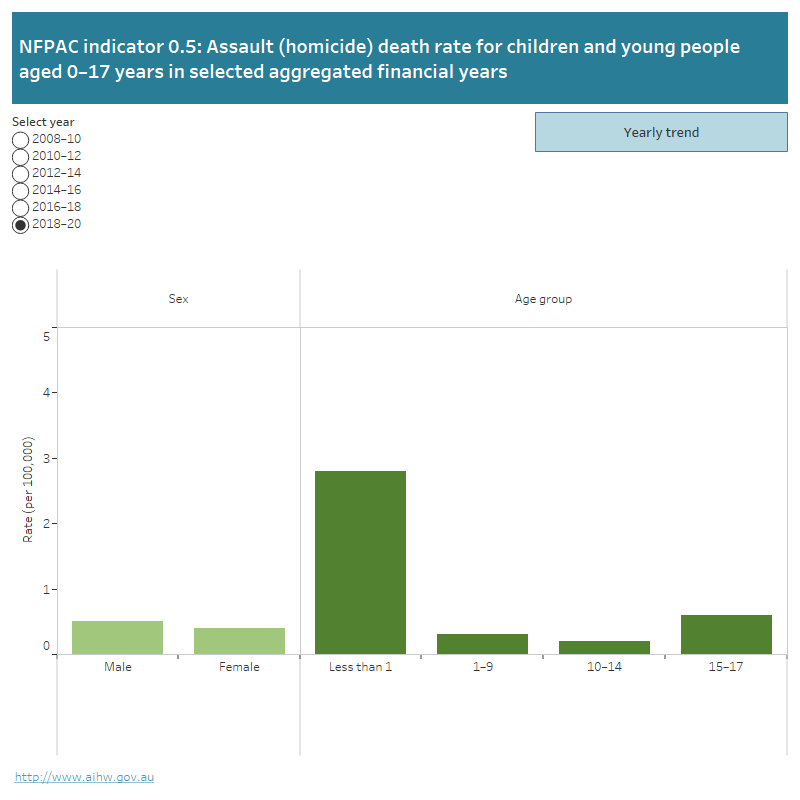0.5 Child homicide
Deaths from assault provide an indication of the extent of extreme interpersonal violence towards children.
Interpersonal violence, including domestic violence and child abuse, is often associated with parental drug and alcohol misuse and mental health problems.
Due to small numbers, these data are aggregated over two-year periods.
Trend data: For all indicator displays, the yearly trend is limited to indicators with 3 or more years (including the current year) of comparable time series data. To see the trend click on “Yearly Trend” button on the display. Where 3 or more years of comparable data including the most recent year is not available, a “No time series data” message is shown on the display.
The first figure is a bar graph showing the assault (homicide) death rate (per 100,000) for children and young people aged 0–17 years, by sex and age group. Data can be presented for select year groups 2008–10 to 2018–20.
The second figure is a line graph showing the assault (homicide) death rate (per 100,000) for children and young people aged 0–17 years from 2008–10 to 2018–20. Data are can be presented by age group or sex.

Source: AIHW analysis of Australian Institute of Criminology (AIC) National Homicide Monitoring Program
See the supplementary data tables for further information and footnotes about these data.
Indicator technical specifications
The information below provides technical specifications for the summary indicator data presented in the quick reference guide.
| Definition | Data source | |
|---|---|---|
| Numerator | Number of deaths of children aged 0–17 years from assault in the reference period | Australian Institute of Criminology National Homicide Monitoring Program (NHMP) |
| Denominator | Number of children aged 0–17 years at 31 December | AIHW Population Database (sourced from ABS Australian Demographic Statistics) |
Explanatory notes
There are two key sources of data for the NHMP: offence records derived from each state/territory police service, supplemented where necessary with information provided directly by investigating police officers and/or associated staff; and state coronial records such as toxicology and post-mortem reports.
The term homicide refers to a person killed (unlawfully). Homicide is defined by the criminal law of each state and territory, and varying definitions exist between jurisdictions in terms of its degree, culpability and intent.
The definition of homicide in the NHMP reflects the operational definition used by police throughout Australia. Excluded from this definition are attempted murder and violent deaths, such as industrial accidents involving criminal negligence (unless a charge of manslaughter is laid). Lawful homicide, including that by police in the course of their duties, is also excluded.
Due to the small number of homicide deaths, reported data are aggregated for a two-year period.
The COVID-19 pandemic and the resulting Australian Government closure of the international border from 20 March 2020, caused significant disruptions to the usual Australian population trends. This report uses Australian Estimated Resident Population (ERP) estimates that reflect these disruptions.
Accordingly, in the year July 2020 to June 2021, the overall population growth was much smaller than the years prior and in particular, there was a relatively large decline in the population of Victoria. ABS reporting indicates these were primarily due to net-negative international migration (National, state and territory population, June 2021 | Australian Bureau of Statistics (abs.gov.au)).
Please be aware that this change in the usual population trends may complicate your interpretation of statistics calculated from these ERPs. For example, rates and proportions may be greater than in previous years due to decreases in the denominator (population size) of some sub-populations.


